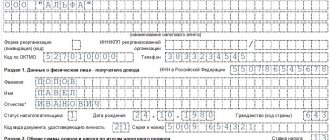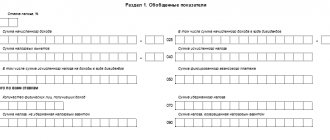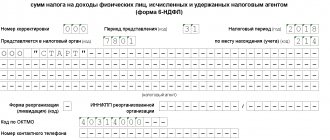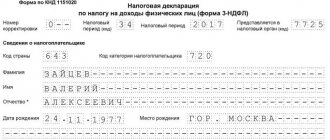Form 6-NDFL was introduced in 2021, but still raises questions about its completion. And all because you need to take into account many details. Let's figure out what kind of insidious document this is.
6-NDFL is a report that declares information about: the amounts of income received by individuals; calculated and withheld personal income tax amounts; dates of actual receipt of income; dates and deadlines for withholding and transferring tax for the reporting period as a whole for the organization (separate division).
Do I need to submit zero 6-NDFL?
As long as payments are not made to individuals and taxable income is not accrued, i.e. all indicators of the 6-NDFL report are equal to “zero”, the obligation to submit 6-NDFL does not arise. There is no need to submit a “zero” 6-NDFL report. But, if you decide to play it safe and submit a “zero” report, the Federal Tax Service is obliged to accept it from you (Letter of the Federal Tax Service dated May 4, 2016 N BS-4-11 / [email protected] ).
It is worth considering that if you made income payments to individuals in the period from the 1st to the 3rd quarter, and in the 4th quarter the income was not accrued and no payments were made, then the obligation to submit 6-NDFL for the 4th quarter remains, because “Section 1” of the declaration is filled out on an accrual basis (Letter of the Federal Tax Service dated March 23, 2016 N BS-4-11/ [email protected] ).
Which income should be reflected in 6-NDFL and which not?
In 6-NDFL, you need to show all income from which personal income tax is subject to withholding as tax agents. Income that is only partially taxed must also be included in the calculation. For example, this could be income in the form of material assistance or the value of gifts, for which there is a limit of 4,000.00 rubles per year, because the total value of such income may exceed the non-taxable minimum during the year. The following income does not need to be included in the calculation of 6-NDFL:
1. Income that is completely exempt from personal income tax.
2. Income of individual entrepreneurs, notaries, lawyers, and other persons engaged in private practice.
3. Income listed in paragraph 1 of Art. 228 Tax Code of the Russian Federation. For example, this could be income from the sale of property owned by an individual.
4. Income of residents of other countries that are not taxed in the Russian Federation by virtue of international treaties.
How is income tax calculated on an accrual basis?
This scheme involves the summation of profits from all types of activities of the company, which are determined every quarter or month. At the same time, expenses are added up, separately direct and indirect.
At the beginning of the next year, taking into account direct expenses, you can obtain the amount of net profit as the difference between profit and direct expenses. This will be the taxable base for the final calculation of tax. It is calculated at a rate of 20% on profits: 17% to the regional treasury, 3% to the federal treasury. This distribution of funds will be valid until 2024. In some cases, the percentage may decrease.
The tax base may be reduced due to expenses for:
- salaries for employees;
- restoration work related to depreciation;
- rental of transport and industrial premises;
- purchase of raw materials, databases and programs;
- payment of interest on debt;
- insurance premiums;
- research works;
- advertising (up to 1% of net revenue).
Declarations for OSNO when calculating on an accrual basis throughout the year are submitted at the end of each month or in April, July, October. The final declaration with the final amount of income tax is prepared in January.
The amounts of advance payments are calculated based on the results of the previous year. If in the 1st quarter the company received losses instead of profits, and in the 2nd, 3rd and 4th there were profits, then the first advance payment will be used for settlements with the tax authorities for the 3rd quarter and year. And for the cumulative total of the 2nd quarter there will be no advance, because there was no income in the previous reporting period.
Let's take another example. Based on the results of the previous year, the payment for the first quarter was determined to be 21,000 rubles, that is, 7,000 rubles each. for a month. Net profit received by quarter:
- RUB 105,000
- RUB 105,000
- 210,000 rub.
- RUB 126,000
The final profit for the year is 526,000 rubles. It is subject to tax at a rate of 20%: 526,000 rubles. * 0.2 = 105,200 rub. Advance payments for 6 and 9 months will be the same as for the first 3, because the financial results in the previous reporting periods are the same. It turns out 21,000 rubles. * 3 = 63,000 rub. It remains to enter the balance of the amount into the January declaration: 105,200 rubles. – 63,000 rub. = 42,200 rub.
The structure of 6-NDFL and the procedure for filling out the calculation according to form 6-NDFL
Form 6-NDFL was approved by Order of the Federal Tax Service of Russia dated October 14, 2015 N ММВ-7-11/ [email protected] and includes the following sections:
1. Title page;
2. Section 1 “Generalized indicators”;
3. Section 2 “Dates and amounts of income actually received and withheld personal income tax.”
The calculation in form 6-NDFL is completed on the reporting date, that is, on March 31, June 30, September 30, December 31 of the corresponding tax period. To fill out the Calculation in Form 6-NDFL, information from tax registers for personal income tax is used.
How is the form filled out - cumulatively or quarterly?
To understand how 6-NDFL is filled out - on an accrual basis or not, let's take a look at the components of this report. According to the order, approved. by order of the Federal Tax Service dated October 15, 2020 No. ED-7-11/ [email protected] (hereinafter referred to as the Procedure), the reporting form for reporting, starting from the 1st quarter of 2021, consists of:
- from the title page (it contains summary information about the reporting company/individual entrepreneur);
- Section 1 with transfer deadlines and personal income tax amounts;
- section 2 (it displays generalized indicators).
As mentioned in the Procedure, the following accounting data is used to fill out the form:
- income that was accrued by tax agents and subsequently paid to individuals;
- deductions provided to taxpayers;
- calculated and withheld tax.
Data is taken from balance sheets and journals maintained for tax and accounting purposes. If it is impossible to place all available indicators on one sheet in the corresponding sections of the report, several pages of the report are filled out.
The tax period - year - must be indicated on the title page. The appropriate code corresponding to the reporting year is placed next to it. Appendix 1 to the Procedure deciphers information about these codes in tabular form. So, if the report is submitted based on the results of the 1st quarter, the code is 21, half a year - 31, 9 months - 33, a whole calendar year - 34.
The report is submitted quarterly. At the same time, in order to understand how 6-NDFL is filled out - on an accrual basis or quarterly, you will need to familiarize yourself in detail with the procedure for entering reporting data. More on this later.
Filling out the Title Page of the 6-NDFL Report for the entire organization, without OP
If you are preparing the 6-NDFL calculation as a whole for an organization that does not have an OP, then everything is simple.
In the “TIN” and “KPP” line, you indicate the TIN and KPP of your organization.
In the Line “Submitted to the tax authority (code),” indicate the code of the Federal Tax Service with which your organization is registered.
In the Line “At the location (accounting) (code)” you must indicate Code “213” “At the place of registration as the largest taxpayer” or “214” “At the location of the Russian organization that is not the largest taxpayer.”
In the “Tax Agent” line, indicate the name of your organization.
In the “OKTMO Code” line, indicate the OKTMO code of your organization.
Filling out the Title Page of Report 6-NDFL for OP
When drawing up the OP Report, you will need to pay attention to filling out the following lines of the Declaration Title Page.
In the “TIN” and “KPP” line, you indicate the TIN of your organization and the KPP of your OP.
In the Line “Submitted to the tax authority (code),” indicate the code of the Federal Tax Service with which your OP is registered.
In the Line “At the location (accounting) (code)” you must indicate Code “220” “At the location of a separate division of the Russian organization.”
In the “Tax Agent” line, indicate the name of your organization.
In the “OKTMO Code” line, indicate the OKTMO code of your OP.
How to form and fill out 6-NDFL?
The reporting includes a title page and two sections, each of which must be completed correctly. Let us list the features of the declaration structure:
- Title page. Includes information about the TIN and KPP of the company, its name, reporting period, tax office number where the document is sent.
- Section 1 contains intermediate information, for example, about which personal income tax was returned for the first quarter and which for 9 months. Provides aggregated data on income, deductions, tax refunded or withheld. General indicators are presented on an accrual basis from the beginning of the reporting year.
- Section 2 contains information for a specific quarter. Previous periods are not taken into account. Information about the dates of receipt of income and withholding of 13%, as well as their amounts, is displayed here.
You can generate a 6-NDFL declaration using the template provided by the tax office, or by downloading a sample with an example on the Federal Tax Service website.
Filling out the Title Page of Report 6-NDFL for a closed OP
How to fill out the Cover Page of the Report on a closed OP depends on the moment you submit 6-NDFL - before the OP is deregistered with the Federal Tax Service or after.
If you submit a report before the OP is deregistered, then nothing changes when drawing up the report. You fill it out as a regular report on an OP and submit it to the Federal Tax Service at the place where this OP is registered.
If you submit a report after deregistration of the OP, then you will need to submit this report to the Federal Tax Service at the place of registration of your parent organization and when drawing up the report, pay attention to filling out the following lines of the Declaration Title Page.
In the “TIN” and “KPP” line, you indicate the TIN of your organization and the KPP of your closed OP.
In the Line “Submitted to the tax authority (code),” indicate the code of the Federal Tax Service where your parent organization is registered.
In the Line “At the location (accounting) (code)” you must indicate Code “213” “At the place of registration as the largest taxpayer” or “214” “At the location of the Russian organization that is not the largest taxpayer.”
In the “Tax Agent” line, indicate the name of your organization.
In the “OKTMO Code” line, indicate the OKTMO code of your closed OP.
The procedure for filling out Section 1 of form 6-NDFL
Section 1 of the calculation includes income, deductions and tax on them as a whole for the organization (OP) for a total of 1 quarter, half a year, 9 months, a year on a cumulative basis from the beginning of the year.
Section 1 can be divided into 2 blocks. Block 1 is lines 010-050 and Block 2 is lines 060-090. Block 1, namely lines 010-050, are filled out separately for each personal income tax rate (if there were payments taxed at different personal income tax rates). But Block - 2, namely lines 060-090, are filled out once, for the entire organization (OP), without detailing personal income tax rates.
Line 010 “Tax rate, %”
This line indicates the personal income tax rate.
Line 020 “Amount of accrued income”
This line reflects the amount of income received by individuals at the rate specified in “Line 010”, if their actual receipt falls on the corresponding reporting period for which the 6-NDFL calculation is made.
The most common mistake when filling out this line is the fact that many people use accounting data to fill out this line, but they need to focus on tax registers.
For example, income under PP is recognized in the period in which it is accrued, but income under civil and gas agreements is recognized in the period in which they are paid. Therefore, to correctly fill out “Line 020”, it is important to correctly determine the date of actual receipt of income. Below is a list of main incomes indicating the date of their actual receipt.
Accordingly, to fill out “Line 020” you need to focus not on the date of accrual of income, but on the date of its actual receipt, which does not always coincide.
Table 1
| No. PP | Type of income | Date of receipt of income | Tax withholding date | Tax payment deadline |
| 1 | 2 | 3 | 4 | 5 |
| 1 | Salary (salary) | Last day of the month | Day of actual salary payment | Next business day after payment |
| 2 | Advance paid on the last day of the month or later | The last day of the month for which the advance was paid | Day of actual payment of Advance | Next business day after payment |
| 3 | Monthly production bonus | Last day of the month for which the Prize is awarded | Day of actual payment of the Prize | Next business day after payment |
| 4 | Quarterly production bonus | Date of payment of the Prize | Date of payment of the Prize | Next business day after payment |
| 5 | Annual production bonus | Date of payment of the Prize | Date of payment of the Prize | Next business day after payment |
| 6 | Non-production bonus | Date of payment of the Prize | Date of payment of the Prize | Next business day after payment |
| 7 | Rewards under GPC agreements | Reward payment date | Reward payment date | Next business day after payment |
| 8 | Vacation pay | Vacation pay date | Vacation pay date | Last day of the month in which Vacation Pay was paid |
| 9 | Sick leave | Sick leave payment date | Sick leave payment date | Last day of the month in which sick leave was paid |
| 10 | Material aid | Income payment date | Income payment date | Next business day after payment |
| 11 | Income in kind, if there are other payments to this employee | Income payment date | The day of actual payment of any income | Next business day after payment |
| 12 | Income in kind, if no other payments were made to this employee | Income payment date | 00.00.0000 | 00.00.0000 |
| 13 | Compensation for unused vacation | Income payment date | Income payment date | Next business day after payment |
| 14 | Income in the form of material benefits from % savings | Last day of the month | The day of actual payment of any income | Next business day after payment |
| 15 | Dividends | Dividend payment date | Dividend payment date | Next business day after payment |
Line 025 “Including the amount of accrued income in the form of dividends”
In this line you need to indicate the amount of dividends that were paid in the current reporting period, taxed at the rate specified in “Line 010”. This amount is informationally highlighted as a separate line, but is included in the total amount of accrued income shown on “Line 020”.
Line 030 “Amount of tax deductions”
Here it is necessary to reflect all deductions that are presented to individuals for the reporting period for the income indicated in “Line 020”. These can be standard, property, social and investment tax deductions. Also, on “Line 030” you need to show amounts that reduce the tax base and non-taxable amounts for income exempt within certain limits. For example, 4,000.00 rub. from gifts received by employees.
Line 040 “Amount of calculated tax”
On “Line 040” you need to indicate the total amount of personal income tax, which was calculated from the income indicated in “Line 020” and at the rate indicated in “Line 010” for the corresponding reporting period.
Line 045 “Including the amount of calculated tax on income in the form of dividends”
For information, you need to indicate the amount of personal income tax that was accrued on the dividends paid specified in “Line 025” and at the rate specified in “Line 010” for the corresponding reporting period.
Line 050 “Amount of fixed advance payment”
This line is filled in only if there are foreign workers who work under a patent.
In this case, here you will need to indicate the total amount of fixed advance payments for personal income tax, by which you reduce the tax of all foreign workers working on a patent.
After you have filled out Block 1, namely lines 010-050 for all bets, you can start filling out Block 2, namely filling out lines 060-090.
Line 060 “Number of individuals who received income”
Here, indicate the total number of employees to whom you paid income during the corresponding reporting period.
Do not include employees who did not receive taxable income in this indicator. If during the reporting period the same person was admitted twice, i.e. was hired, then fired and then hired again, it must be indicated once.
Line 070 “Amount of tax withheld”
On “Line 070” you need to indicate the amount of tax withheld during the reporting period at the time of payment of income. The fundamental difference between the indicators of Lines 040 and 070 is that “Line 040” indicates the amount of personal income tax on income received but not paid, and “Line 070” indicates the amount of personal income tax on transferred income. Those. these indicators may take unequal values. For example, personal income tax, which is withheld from the salary for December in January, is not reflected in “Line 070” of the calculation of 6-NDFL for the year, but is included in “Line 070” of the calculation of 6-NDFL for the 1st quarter of the next year.
Line 080 “Amount of tax not withheld by the tax agent”
On this line you need to indicate the amount of personal income tax that has been calculated but not withheld. For example, if the income was paid in kind and no other payments were made. Those. These are the tax amounts for which you must submit Certificate 2-NDFL with sign “2”.
You do not need to show income that you will retain in subsequent reporting periods on this line. For example, “Line 080” of Report 6-NDFL for the 1st quarter does not indicate the amount of personal income tax from the salary for March, which will be withheld in the 2nd quarter.
Line 090 “Tax amount returned by the tax agent”
Here we indicate the total amount of tax returned to the individual by the tax agent.
Where and when to submit 6-NDFL?
The completed 6-NDFL must be sent to the tax office at the individual entrepreneur’s registration address. If the company has separate divisions, then you can submit documents at their location. If there is a digital signature, the taxpayer has the opportunity to transfer information through his personal account. If employees did not receive payments during the reporting period, there is no need to provide data.
Tax agents are required to prepare a declaration four times a year:
- until the end of April - for the first quarter;
- until the end of July - six months;
- until the end of October - 9 months;
- before the beginning of March next year - a year.
If the last day for submitting documents falls on a weekend, it will be transferred to the next working day.







